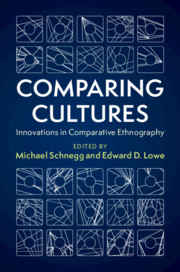Book contents
- Comparing Cultures
- Comparing Cultures
- Copyright page
- Contents
- Figures
- Tables
- Contributors
- Introduction
- Part I Binary Comparisons
- 1 Thinking with Comparison in the Anthropology/Historical Anthropology of Migration
- 2 Comparing Tangerines
- 3 A Comparative Ethnographic Study of Suicide Epidemics in Two Pacific Island Societies
- Part II Regional Comparisons
- Part III Distant and Fluid Comparisons
- Index
- References
3 - A Comparative Ethnographic Study of Suicide Epidemics in Two Pacific Island Societies
from Part I - Binary Comparisons
Published online by Cambridge University Press: 08 May 2020
- Comparing Cultures
- Comparing Cultures
- Copyright page
- Contents
- Figures
- Tables
- Contributors
- Introduction
- Part I Binary Comparisons
- 1 Thinking with Comparison in the Anthropology/Historical Anthropology of Migration
- 2 Comparing Tangerines
- 3 A Comparative Ethnographic Study of Suicide Epidemics in Two Pacific Island Societies
- Part II Regional Comparisons
- Part III Distant and Fluid Comparisons
- Index
- References
Summary
This chapter argues that critical-comparative studies of two cases can offer context-sensitive and more valid accounts of social problems that accompany intensified global flows in an era of advanced capitalism. This chapter presents a critical-comparative analysis of well-documented suicide epidemics in Chuuk and Samoa. The analysis proceeds in three steps. The analysis begins with an incommensurate mode of comparison of ethnopsychologies of emotion and the management of anger as these contrast with dominant understandings in Western academic psy-disciplines. Second, the analysis compares the organization of everyday social and material reproduction in each site. This analysis provides insight into the local political-economic and social organizational processes that create social-structural disparities in terms of the vulnerabilities associated with self-harm as a strategy of the management of emotions and social-relational protest. The final step examines how each case is nested within wider political-economic and material processes and flows, creating differential sites of collective vulnerability to epidemic suicide at particular historical junctures.
- Type
- Chapter
- Information
- Comparing CulturesInnovations in Comparative Ethnography, pp. 69 - 90Publisher: Cambridge University PressPrint publication year: 2020



